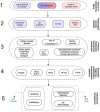Nature's Electric Potential: A Systematic Review of the Role of Bioelectricity in Wound Healing and Regenerative Processes in Animals, Humans, and Plants
- PMID: 28928669
- PMCID: PMC5591378
- DOI: 10.3389/fphys.2017.00627
Nature's Electric Potential: A Systematic Review of the Role of Bioelectricity in Wound Healing and Regenerative Processes in Animals, Humans, and Plants
Abstract
Natural endogenous voltage gradients not only predict and correlate with growth and development but also drive wound healing and regeneration processes. This review summarizes the existing literature for the nature, sources, and transmission of information-bearing bioelectric signals involved in controlling wound healing and regeneration in animals, humans, and plants. It emerges that some bioelectric characteristics occur ubiquitously in a range of animal and plant species. However, the limits of similarities are probed to give a realistic assessment of future areas to be explored. Major gaps remain in our knowledge of the mechanistic basis for these processes, on which regenerative therapies ultimately depend. In relation to this, it is concluded that the mapping of voltage patterns and the processes generating them is a promising future research focus, to probe three aspects: the role of wound/regeneration currents in relation to morphology; the role of endogenous flux changes in driving wound healing and regeneration; and the mapping of patterns in organisms of extreme longevity, in contrast with the aberrant voltage patterns underlying impaired healing, to inform interventions aimed at restoring them.
Keywords: Vmem; electric field; regeneration; voltage mapping; wound current.
Figures




Similar articles
-
Bioelectrical control of positional information in development and regeneration: A review of conceptual and computational advances.Prog Biophys Mol Biol. 2018 Sep;137:52-68. doi: 10.1016/j.pbiomolbio.2018.03.008. Epub 2018 Apr 5. Prog Biophys Mol Biol. 2018. PMID: 29626560 Free PMC article. Review.
-
Electrochemical patterns during Drosophila oogenesis: ion-transport mechanisms generate stage-specific gradients of pH and membrane potential in the follicle-cell epithelium.BMC Dev Biol. 2019 Jun 21;19(1):12. doi: 10.1186/s12861-019-0192-x. BMC Dev Biol. 2019. PMID: 31226923 Free PMC article.
-
Endogenous Voltage Potentials and the Microenvironment: Bioelectric Signals that Reveal, Induce and Normalize Cancer.J Clin Exp Oncol. 2013;Suppl 1:S1-002. doi: 10.4172/2324-9110.S1-002. J Clin Exp Oncol. 2013. PMID: 25525610 Free PMC article.
-
Bioelectric patterning during oogenesis: stage-specific distribution of membrane potentials, intracellular pH and ion-transport mechanisms in Drosophila ovarian follicles.BMC Dev Biol. 2015 Jan 16;15:1. doi: 10.1186/s12861-015-0051-3. BMC Dev Biol. 2015. PMID: 25591552 Free PMC article.
-
Bioelectricity and epimorphic regeneration.Bioessays. 2007 Nov;29(11):1133-7. doi: 10.1002/bies.20656. Bioessays. 2007. PMID: 17935197 Review.
Cited by
-
Engineering 3D Scaffold-Free Nanoparticle-Laden Stem Cell Constructs for Piezoelectric Enhancement of Human Neural Tissue Formation and Function.Adv Sci (Weinh). 2024 Oct;11(40):e2310010. doi: 10.1002/advs.202310010. Epub 2024 Jul 25. Adv Sci (Weinh). 2024. PMID: 39049737 Free PMC article.
-
Role of Bioelectricity During Cell Proliferation in Different Cell Types.Front Bioeng Biotechnol. 2020 Jul 2;8:603. doi: 10.3389/fbioe.2020.00603. eCollection 2020. Front Bioeng Biotechnol. 2020. PMID: 32714900 Free PMC article.
-
Insights into regeneration tool box: An animal model approach.Dev Biol. 2019 Sep 15;453(2):111-129. doi: 10.1016/j.ydbio.2019.04.006. Epub 2019 Apr 13. Dev Biol. 2019. PMID: 30986388 Free PMC article. Review.
-
PEDOT:PSS-Coated Polybenzimidazole Electroconductive Nanofibers for Biomedical Applications.Polymers (Basel). 2021 Aug 19;13(16):2786. doi: 10.3390/polym13162786. Polymers (Basel). 2021. PMID: 34451324 Free PMC article.
-
Non-invasive micro-test technology and applications.Biophys Rep. 2025 Apr 30;11(2):96-111. doi: 10.52601/bpr.2024.240009. Biophys Rep. 2025. PMID: 40308937 Free PMC article.
References
Publication types
LinkOut - more resources
Full Text Sources
Other Literature Sources

